<< Previous | Displaying results 6626-6650 of 6769 for "" | Next >>
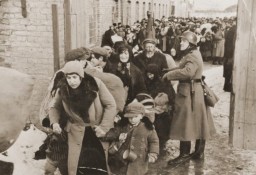
Nyanza is a site near Kigali, Rwanda, where several thousand people were executed after being marched from the Belgian Technical School in April 1994. At the school, they had been under the protection of UN peacekeepers until the soldiers were recalled to the airport to help evacuate expatriates. This is one of the few sites where victims had the honor of individual burial; most often they were buried together in large graves. Photograph taken on November 24, 2007. United States Holocaust Memorial Museum
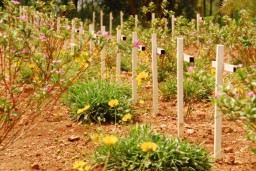
Refugee women and children arrive by truck in Tuzla during the Bosnian War, which lasted from 1992 to 1995. They are likely coming from Srebrenica. Photo taken in March 1993.
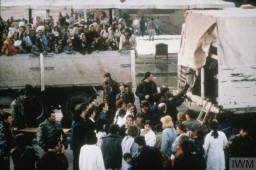
Dated June 6, 1944, this US Twelfth Army Group situation map shows the presumed locations of Allied and Axis forces on D-Day, when Allied troops landed on the beaches of Normandy. Drafted during the war, the content in this historical map reflects the information that operational commander, General Omar N. Bradley, would have had on hand at the time.

Canadian troops of the 'B' Company, North Shore (New Brunswick) Regiment take cover on June 6, 1944, or D-Day.
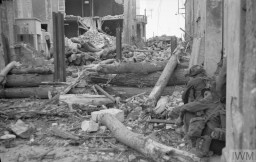
Captain Lasdun briefs troops of the British Army on June 4, 1944, two days before the Allied invasion of Normandy on D-Day.
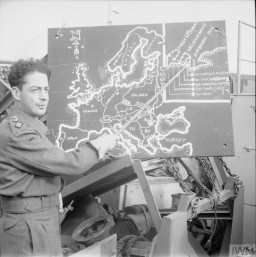
Salek Liwer (center) with friends at a Dror Zionist youth movement seminar in the Bad Gastein displaced persons camp in Austria, 1946.
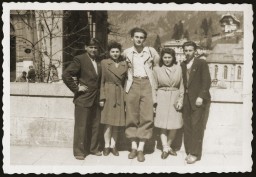
Jewish DP David Bromberg poses at the entrance to a barrack in the Ebensee displaced persons camp on October 30, 1946.
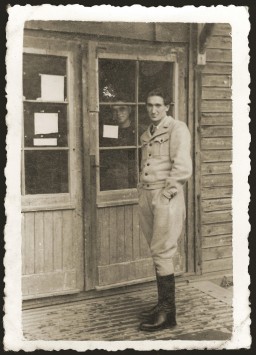
After World War II, the Rothschild hospital in Austria was primarily concerned with the rehabilitation of sick displaced persons. It also served as a lager for political prisoners and as a hostel for 600 refugees.
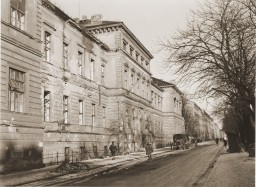
Jewish DPs (displaced persons) celebrate at a banquet at the Rothschild Hospital DP center.
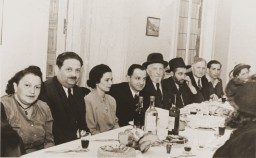
Jewish DPs from the New Palestine displaced persons camp in Salzburg, Austria, gather around a memorial dedicated to the Jewish victims of the Nazis. Among those pictured is Moniek Rozen (third from the left), Kazik Szancer (fourth from the left) and Rela Szancer (fifth from the left).
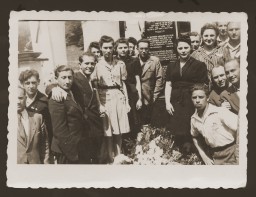
Displaced persons (DPs), Lusia Gliklich (left) and Andzia Dell, stand beside the sign in front of the Düppel Center DP camp, also called Schlachtensee.
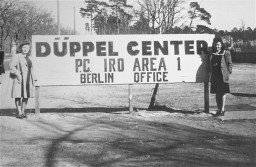
This report card was issued to Regina Laks, a fifth-grade student at the Herzel Hebrew Public School at the Düppel Center displaced persons camp.
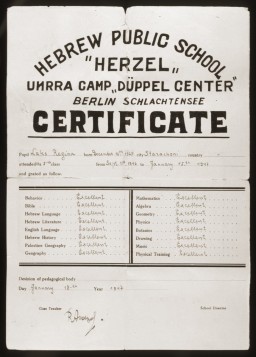
This identity card was issued to Henryk Lanceter at the Fürth Displaced Persons Camp in Germany.
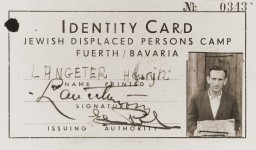
This identification card was issued to Sima Wajner, a Jewish resident of the Heidenheim displaced persons camp. The card identifies her as a former concentration camp inmate who had been imprisoned in the Stuffhof camp during the Holocaust. Card dated January 23, 1947.
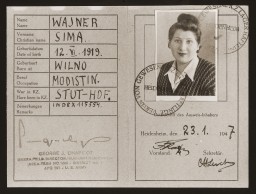
Jewish displaced persons (DPs) and American soldiers at the Heidenheim DP camp, circa 1946–1947. Leon Kliot (Klott) is standing on the far right, third from the top.

Young Jewish displaced persons (DPs) on a street in the Lampertheim DP camp, circa 1946–1948.

Group portrait of Jewish displaced persons (DPs) in the Leipheim DP camp. From left to right are an unidentified couple, Rubin Kaplan, Zalman Kaplan (cousin), Dwora (cousin) and her husband Eli Flaks, and their infant, Pearl.
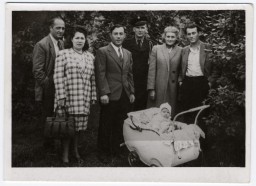
Bialik kindergarten students pose together in the Mariendorf displaced persons (DP) camp, circa 1946–1948. The children hold a banner that reads, "Ch, N. Bialik Kindergarten." A portrait of Theodor Herzl hangs on the back wall. Above the portrait is is a Hebrew banner that reads "Our children, the future of our nation." Benjamin Markowicz is in the fourth row, second from the left.

View of the Mariendorf displaced persons (DP) in Berlin, Germany, 1946–1948.
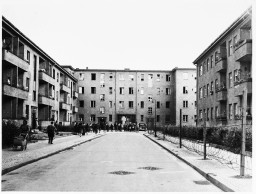
Jewish displaced persons (DPs) converse on the streets of the Neu Freimann DP camp, circa 1946–1948.The photographer, Jack Sutin, lived at the camp with his family and worked as a camp administrator and photojournalist.
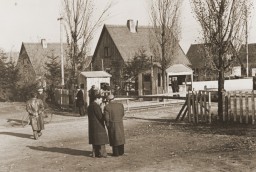
Dental technicians prepare molds at the Neu Freimann displaced persons (DP) camp, circa 1945–1949. Neu Freimann had its own dental treatment facility. The photographer, Jack Sutin, lived at the camp with his family and worked as a camp administrator and photojournalist.
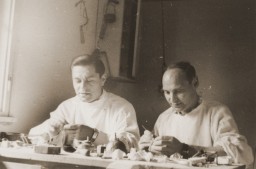
Elementary school-age members of Hashomer Hatzair in the Stuttgart displaced persons camp, circa 1946–1949. Lova Warszawczyk is standing in the center.
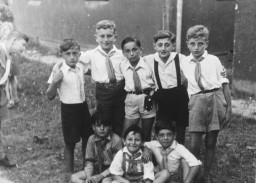
Henry Brauner (center) with his wife, Esther (second from right), pose with three friends in front of the entrance to the Stuttgart West displaced persons (DP) camp, 1945.
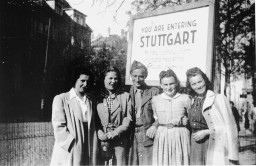
A view of the housing for Jewish displaced persons (DPs) at the Wetzlar DP camp in Germany, September 9, 1948.
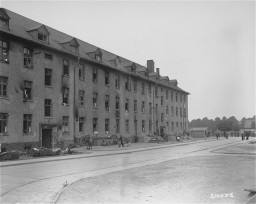
We would like to thank Crown Family Philanthropies, Abe and Ida Cooper Foundation, the Claims Conference, EVZ, and BMF for supporting the ongoing work to create content and resources for the Holocaust Encyclopedia. View the list of donor acknowledgement.